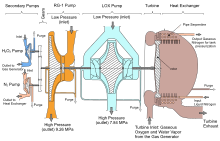The RD-107 and its sibling, the RD-108, are a type of rocket engine used on the R-7 rocket family. RD-107 engines are used in each booster and the RD-108 is used in the central core. The engines have four main combustion chambers (each a with nozzle) and either two (RD-107) or four (RD-108) vernier chambers.
The engines were first developed in the mid-1950s to launch the R-7 Semyorka, the first intercontinental ballistic missile. The R-7 was later adapted into space launch vehicles and the engines have been improved over several generations. The most recent versions are the RD-107A and RD-108A engines are used to launch the Soyuz-2, which is in active service as of 2024[update].

The RD-107 was designed under the direction of Valentin Glushko at the Experimental Design Bureau (OKB-456) between 1954 and 1957. It uses liquid oxygen and kerosene as propellants operating in a gas generator cycle. As was typical by all the descendants of the V-2 rocket technology, the turbine is driven by steam generated by catalytic decomposition of H₂O₂. The steam generator uses solid F-30-P-G catalyst. These are based on a variable sized pellet covered in an aqueous solution of potassium permanganate and sodium. Each engine uses four fixed main combustion chambers. The RD-107 has an additional two vernier combustion chambers that can thrust vector in a single plane to supply attitude control. The RD-108 has four verniers to supply full vector control to the Blok-A stage. The single-axle turbopump unit includes the steam driven turbine, an oxidizer pump, a fuel pump, and a nitrogen gas generator for tank pressurization.[3]
The RD-107 engines are used in each of the boosters of the Soyuz-2 rocket, and a single RD-108 is used in the Blok-A stage (the central 1st stage).
One important innovation of this engine was the capability to use variable mixture ratio between fuel and oxidizer. The natural variations in manufacturing between each engine meant that without an active propellant consumption control, each booster could deplete oxygen and fuel at a different rate. This might result in as much as tens of tonnes of unused propellant near the end of the burn. It would generate enormous stress on the structure and cause difficulties in steering due to the mass imbalance. The mixture ratio control system was developed to ensure the simultaneous consumption of propellant mass among the four R-7 boosters.[3][7]
The RD-107 and RD-108 engines are produced at the JSC Kuznetsov plant in Samara, Russia, under the supervision of the Privolzhskiy branch of NPO Energomash, also known as the Volga branch.[1][3][5] The Privolzhsky branch was organized as a branch of OKB-456 in 1958, specifically for the manufacture of RD-107 and RD-108 engines. The branch was led by Y.D. Solovjev until 1960, then by R.I. Zelenev until 1975, then by A.F. Udalov until 1978, and is currently led by A.A. Ganin.[8]

Modifications to the RD-107 design have led to production of several distinct versions of the engine:
Similar modifications have led to several distinct versions of the RD-108:
Work on the 14D21 and 14D22 engines started in 1986, with a preliminary design completed in 1993. These engines incorporate a new injector head design to increase specific impulse. The first launch of a Progress cargo spacecraft using a launch vehicle equipped with these engines took place in May 2001. The first human spaceflight launch utilizing these engines took place in October 2002.[5]
Currently produced engines are ignited with a pyrotechnic ignition system. Energomash reports a new, hypergolic ignition system (on engines designated 14D21KhZ and 14D22KhZ) are ready for certification and flight tests.[5]